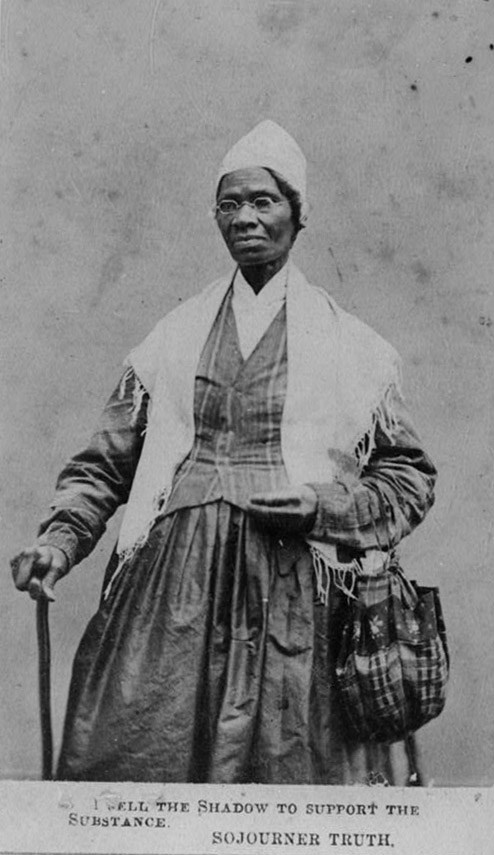The Woman Whose Name I Shall Not Mention Again

Built-in into slavery in 1797, Isabella Baumfree, who later changed her name to Sojourner Truth, would become i of the well-nigh powerful advocates for human rights in the nineteenth century. Her early childhood was spent on a New York manor owned by a Dutch American named Colonel Johannes Hardenbergh. Similar other slaves, she experienced the miseries of being sold and was cruelly beaten and mistreated. Effectually 1815 she barbarous in love with a fellow slave named Robert, only they were forced apart by Robert'south main. Isabella was instead forced to marry a slave named Thomas, with whom she had five children.
In 1827, after her chief failed to honor his promise to free her or to uphold the New York Anti-Slavery Law of 1827, Isabella ran away, or, as she afterwards informed her chief, "I did non run away, I walked away by daylight…." After experiencing a religious conversion, Isabella became an itinerant preacher and in 1843 changed her proper noun to Sojourner Truth. During this menses she became involved in the growing antislavery movement, and by the 1850s she was involved in the adult female's rights movement as well. At the 1851 Women'south Rights Convention held in Akron, Ohio, Sojourner Truth delivered what is now recognized as one of the almost famous abolitionist and women'southward rights speeches in American history, "Own't I a Woman?" She continued to speak out for the rights of African Americans and women during and later on the Ceremonious War. Sojourner Truth died in Boxing Creek, Michigan, in 1883.
Sojourner Truth (1797-1883): Own't I A Woman?
Delivered 1851
Women's Rights Convention, Old Rock Church building (since demolished), Akron, Ohio
Well, children, where there is so much dissonance there must be something out of kilter. I think that 'twixt the negroes of the South and the women at the North, all talking about rights, the white men volition be in a gear up pretty before long. Only what'south all this here talking nigh? That man over at that place says that women need to exist helped into carriages, and lifted over ditches, and to have the best identify everywhere. Nobody ever helps me into carriages, or over mud-puddles, or gives me whatever best place! And ain't I a woman? Look at me! Expect at my arm! I take ploughed and planted, and gathered into barns, and no homo could head me! And ain't I a adult female? I could work every bit much and swallow equally much every bit a man - when I could become it - and bear the lash as well! And ain't I a woman? I take borne thirteen children, and seen most all sold off to slavery, and when I cried out with my mother'south grief, none but Jesus heard me! And ain't I a woman? So they talk about this thing in the head; what'south this they phone call it? [member of audience whispers, "intellect"] That'southward it, love. What's that got to practice with women'southward rights or negroes' rights? If my loving cup won't hold but a pint, and yours holds a quart, wouldn't you be mean not to let me have my little one-half measure full? And then that fiddling homo in blackness there, he says women can't have as much rights equally men, 'cause Christ wasn't a woman! Where did your Christ come from? Where did your Christ come from? From God and a adult female! Homo had naught to do with Him. If the offset woman God ever made was strong enough to turn the world upside down all lone, these women together ought to be able to plow it back , and go information technology correct side up again! And now they is request to do it, the men better allow them. Obliged to you for hearing me, and now quondam Sojourner ain't got zero more to say.
But Await!
At that place is some controversy regarding Sojourner Truth's famous 'Ain't I a Woman?' Speech listed above. There are different versions of the speech. The popular 'Ain't I a Woman' Speech was first published by Frances Gage in 1863, 12 years after the speech itself. Another version was published a month afterward the speech was given in the Anti-Slavery Bugle by Rev. Marius Robinson. In Robinson's Version the phrase 'Ain't I a Woman' is not present.
Compare the speeches and decide yourself at the Library of Congress or at The Sojourner Truth Project. [2]
[1] This text is part of the Internet Modernistic History Sourcebook.
[ii] This article first appeared on the Women's Rights National Historical Park website.
Source: https://www.nps.gov/articles/sojourner-truth.htm
0 Response to "The Woman Whose Name I Shall Not Mention Again"
Post a Comment